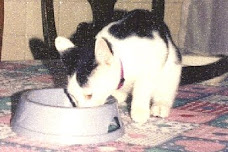This is what I got from Susan's pet food newsletter. I changed brands ... yes, it costs more but I'm more comfortable with my choice.
‘Wheat Gluten’, ‘Corn Gluten’, or ‘Rice Gluten’. These three ingredients were the bad boy pet food ingredients of 2007. Tainted glutens were found to be the cause of thousands of dogs and cats becoming ill and dying. It is not that glutens themselves are toxic to pets – these ingredients have been used in pet foods for years.
The problem was the source or manufacturer of the glutens – imported from countries with far less quality standards than in the US. The majority of glutens used in the US pet foods are from imported sources. These imported glutens contained added chemicals that caused crystals to form in the kidneys of dogs and cats.
Not only is it important to avoid dog foods and cat foods (and dog and cat treats) that contain glutens because of the possibility of dangerous added chemicals, it is important because they add no real quality nutrition to the food. Glutens are used as a thickener AND as a source of protein in pet food. Adult maintenance dog foods must provide a minimum of 18% protein, adult maintenance cat foods must provide a minimum of 26% protein. If the meat source of the pet food does not provide enough protein, glutens are often added to boost the protein level of the pet food.
The best nutrition for your pet comes from a meat protein pet food not from a gluten protein. Avoid dog foods and cat foods (and treats) that contain ‘corn gluten’, ‘wheat gluten’, or ‘soy gluten’.
‘By Products’. By-products have never been the cause of a pet food recall, but they are definitely ingredients you want to avoid feeding your pet. To give you an understanding of by-products, I’d like to compare this pet food ingredient to pies – you know, the dessert! How many different types of pies you can think of? There are apple pies, cherry pies, chocolate pies, meringue pies, meat pies, mud pies, pie in math, cow pies (yuck!) – I think you get my point. Now imagine if you purchased yourself a prepared ravioli dinner at the grocery and you looked at the ingredients and you see ‘pie’ listed as the first ingredient in your dinner. Hmmm, pie in ravioli – what kind of pie? You wouldn’t know if it was apple pie or mud pie or even cow pie. All you would know is that your dinner contained ‘pie’. Considering ‘pie’ could be anything from apple pie to cow pie – my guess is that you wouldn’t be having ravioli for dinner. Same thing with by-products in pet food.
AAFCO (American Association of Feed Control Officials – the organization responsible for all animal feed manufacturing rules and regulations) defines by-products as “meat by-products is the non-rendered, clean parts, other than meat, derived from slaughtered mammals. It includes, but is not limited to, lungs, spleen, kidneys, brain, livers, blood, bone, partially defatted low temperature fatty tissue, and stomachs and intestines freed of their contents. It does not include hair, horns, teeth, and hoofs. It shall be suitable for use in animal food. If it bears name descriptive of its kind, it must correspond thereto.”
So, with respect to pet food – a by-product is a catch-all ingredient name. All left over meat materials from the human food industry are clumped into one ingredient name – by-product. There is NO certainty of what you are feeding – one batch of pet food might be more intestine by-products while the next batch of pet food might be more liver or bone by-products. There is NO way of knowing what is actually contained in the pet food ingredient by-product (the pet food manufacturers themselves couldn’t tell you exactly). Avoid dog foods and cat foods (and treats) that contain By-products of any kind …Chicken By-Products, Beef By-Products, Chicken By-Product Meal, Beef By-Product Meal, and so forth.
‘Meat Meal’, ‘Meat and Bone Meal’, or ‘Animal Digest’. These three ingredients are similar to by-products. AAFCO defines Meat and Bone Meal as “the rendered product from mammal tissues, including bone, exclusive of any added blood, hair, hoof, horn, hide trimmings, manure, stomach and rumen contents, except in such amounts as may occur unavoidably to good processing practices.” Again, a catch all ingredient name for the left-over parts of animals used for human food. No consistency to what is contained in these ingredients (all three of these pet food ingredient definitions are similar) – no way of knowing what is actually in your pet’s food. Avoid dog foods, cat foods, and dog and cat treats that contain ‘meat meal’, ‘meat and bone meal’, or ‘animal digest’.
‘Animal Fat’. In 2002 the FDA tested many different brands of dog food (cat food was not tested) for the presence of the drug pentobarbital. Many brands of dog food tested positive to contain the drug. Pentobarbital is the drug used to euthanize dogs, cats, cattle, and horses.
How can the drug that is used to euthanize animals be found in pet food? The answer – euthanized animals are rendered (cooked) and the end ingredients are placed in pet food. It has long been rumored that euthanized dogs and cats (from animal shelters and veterinarian offices) is the major source of the pentobarbital in pet food. However, no one has been able to prove or disprove this rumor to date. The FDA/CVM (Center for Veterinary Management) developed testing methods on two separate occasions to determine the species source of the drug. No results have ever been determined. The pet food manufacturers adamantly deny they use rendered dogs or cats – but NO clinical evidence has ever been released to confirm the pentobarbital is from euthanized cattle and horses in pet food as they claim.
However, the one thing the FDA/CVM has determined through their testing is the pet food ingredient ‘animal fat’ is the most common ingredient to contain pentobarbital. In other words, if you are feeding a dog food or cat food (or treats) with the ingredient ‘animal fat’ in the ingredient listing – you are (more than likely) feeding your pet euthanized animals. Not every batch of pet food tested that contained the ingredient ‘animal fat’ has proved to contain pentobarbital – but why would any pet owner want to take the chance? Avoid dog foods, cat foods, and dog and cat treats that contain the ingredient ‘animal fat’.
‘BHA’, ‘BHT’, ‘TBHQ’, and ‘Ethoxyquin’. These pet food ingredients are chemical preservatives and you might have to look through the entire ingredient list to find them. It is worth the look because there is plenty of clinical evidence to associate all four of these chemical preservatives with cancer and tumors (simply do a Google search on any one of these chemicals). All four of these chemical preservatives are rarely used to preserve human food and if so, are used in quantities far less than what is allowed in pet food. Avoid any dog food, cat food, or dog and cat treat that contains ‘BHA’, ‘BHT’, ‘TBHQ’, and ‘Ethoxyquin’ on the label.
‘Corn’, ‘Wheat’, ‘Soy’. While there is no scientific evidence that proves these ingredients are dangerous to pets – they are potentially dangerous ingredients associated with recalls in the past (1995, 1999, and 2005). These grains are highly prone to a deadly mold (aflatoxin). It is suggested (by AAFCO) that all pet food manufacturers test grains for the mold, but as recalls of the past have proven – that doesn’t always happen. I do not think these ingredients are as risky as others mentioned above, but they are ingredients I avoid for my own pets.
There is more to selecting a true healthy pet food for your dog or cat than avoiding the above mentioned ingredients. This is just a start - based on pet food history, AAFCO ingredient definitions, science and opinion of many pet food experts including myself. There are many quality pet foods available that do NOT use the above ingredients and that add health promoting ingredients to their foods and treats. Continue to learn as much as you can about what you are feeding your pet and ALWAYS read the labels!
All rights reserved PPC Publications








No comments:
Post a Comment